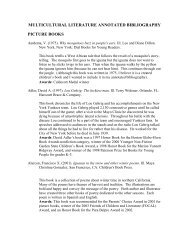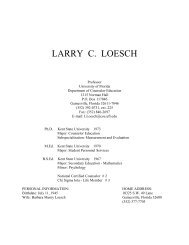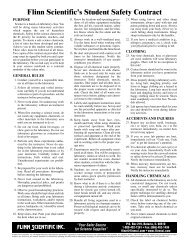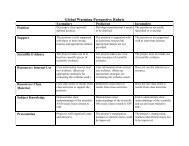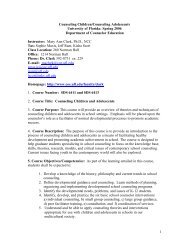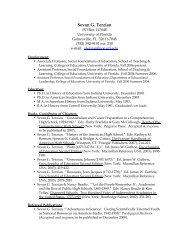The Effects of Distance Education on K-12 Student Outcomes: A ...
The Effects of Distance Education on K-12 Student Outcomes: A ...
The Effects of Distance Education on K-12 Student Outcomes: A ...
You also want an ePaper? Increase the reach of your titles
YUMPU automatically turns print PDFs into web optimized ePapers that Google loves.
Instructi<strong>on</strong><br />
2003<br />
Texas<br />
<str<strong>on</strong>g>Educati<strong>on</strong></str<strong>on</strong>g><br />
Agency 2003*<br />
9-11 English,<br />
Mathematics,<br />
Science,<br />
Social Studies<br />
State<br />
charter<br />
* indicates studies yielding multiple effect sizes<br />
State test Full program Combinati<strong>on</strong> 15-21 -0.014 0.445/-<br />
0.474<br />
Statistical analysis <str<strong>on</strong>g>of</str<strong>on</strong>g> effect sizes<br />
<str<strong>on</strong>g>The</str<strong>on</strong>g> test for heterogeneity (Q), based <strong>on</strong> Hedges and Olkin (1985), was used to determine<br />
whether the effect sizes <str<strong>on</strong>g>of</str<strong>on</strong>g> the studies were homogenously distributed, in other words, to learn<br />
whether the distributi<strong>on</strong> <str<strong>on</strong>g>of</str<strong>on</strong>g> effect sizes around their mean was what would be expected from<br />
sampling error al<strong>on</strong>e (Lipsey & Wils<strong>on</strong> 2001). <str<strong>on</strong>g>The</str<strong>on</strong>g> Q value for the weighted effect sizes was<br />
1.485, and was c<strong>on</strong>sidered to be homogeneous, indicating that the variance observed was likely<br />
to be due to sampling error. <str<strong>on</strong>g>The</str<strong>on</strong>g>refore, the fixed-effects model was used to estimate variance<br />
(Kromrey & Hogarty 2002). Study feature analyses were performed to determine the extent to<br />
which student outcomes were moderated by the study variables. Statistical Analysis System<br />
(SAS) s<str<strong>on</strong>g>of</str<strong>on</strong>g>tware was used for the analyses. Effect size comparis<strong>on</strong>s were d<strong>on</strong>e for the variables:<br />
grade level, c<strong>on</strong>tent area, durati<strong>on</strong> and frequency <str<strong>on</strong>g>of</str<strong>on</strong>g> the distance learning experience,<br />
instructi<strong>on</strong>al role <str<strong>on</strong>g>of</str<strong>on</strong>g> the distance educati<strong>on</strong>, pacing <str<strong>on</strong>g>of</str<strong>on</strong>g> the instructi<strong>on</strong>, role <str<strong>on</strong>g>of</str<strong>on</strong>g> the instructor,<br />
timing <str<strong>on</strong>g>of</str<strong>on</strong>g> the interacti<strong>on</strong>s, and types <str<strong>on</strong>g>of</str<strong>on</strong>g> interacti<strong>on</strong>s, as well as for various study quality and<br />
invalidity factors.<br />
Results<br />
Characteristics <str<strong>on</strong>g>of</str<strong>on</strong>g> the Studies<br />
<str<strong>on</strong>g>The</str<strong>on</strong>g> 14 studies included in the analysis yielded 116 independent effect sizes drawn from a<br />
combined sample <str<strong>on</strong>g>of</str<strong>on</strong>g> 7561 students whose performance as a result <str<strong>on</strong>g>of</str<strong>on</strong>g> participati<strong>on</strong> in a distance<br />
educati<strong>on</strong> program was compared to c<strong>on</strong>trol groups in which students did not participate in<br />
distance educati<strong>on</strong>. Sixty <strong>on</strong>e percent <str<strong>on</strong>g>of</str<strong>on</strong>g> the study results had sample sizes <str<strong>on</strong>g>of</str<strong>on</strong>g> less than 50, and<br />
16% had sample sizes above 100. All but <strong>on</strong>e <str<strong>on</strong>g>of</str<strong>on</strong>g> the studies included more than <strong>on</strong>e comparis<strong>on</strong>,<br />
and the average number <str<strong>on</strong>g>of</str<strong>on</strong>g> comparis<strong>on</strong>s per study was 8, ranging from <strong>on</strong>e to 38. Eighty six<br />
percent <str<strong>on</strong>g>of</str<strong>on</strong>g> the studies were organizati<strong>on</strong> reports, 7% were published articles, and 7% were<br />
dissertati<strong>on</strong>s. All <str<strong>on</strong>g>of</str<strong>on</strong>g> the studies were published between 1999 and 2004, with eleven published<br />
during 2003 and 2004, and three published from 1999 through 2001. Two studies were published<br />
in Canada, and the other twelve were published in the U.S.<br />
A range <str<strong>on</strong>g>of</str<strong>on</strong>g> distance learning structures was examined in the literature. Half <str<strong>on</strong>g>of</str<strong>on</strong>g> the studies<br />
reported <strong>on</strong> programs that used asynchr<strong>on</strong>ous timing in instructi<strong>on</strong>. Three studies documented a<br />
program that used a combinati<strong>on</strong> <str<strong>on</strong>g>of</str<strong>on</strong>g> synchr<strong>on</strong>ous and asynchr<strong>on</strong>ous instructi<strong>on</strong>, <strong>on</strong>e program was<br />
delivered synchr<strong>on</strong>ously, and the remaining programs did not report <strong>on</strong> instructi<strong>on</strong>al timing. Ten<br />
<str<strong>on</strong>g>of</str<strong>on</strong>g> the studies reported results <str<strong>on</strong>g>of</str<strong>on</strong>g> student participati<strong>on</strong> in full year-l<strong>on</strong>g distance learning<br />
programs, <strong>on</strong>e included data for distance learning courses, and three studies focused <strong>on</strong> porti<strong>on</strong>s<br />
<str<strong>on</strong>g>of</str<strong>on</strong>g> courses delivered at a distance for less than a semester. Thirteen studies included data from<br />
<strong>12</strong> <str<strong>on</strong>g>of</str<strong>on</strong>g> 32



